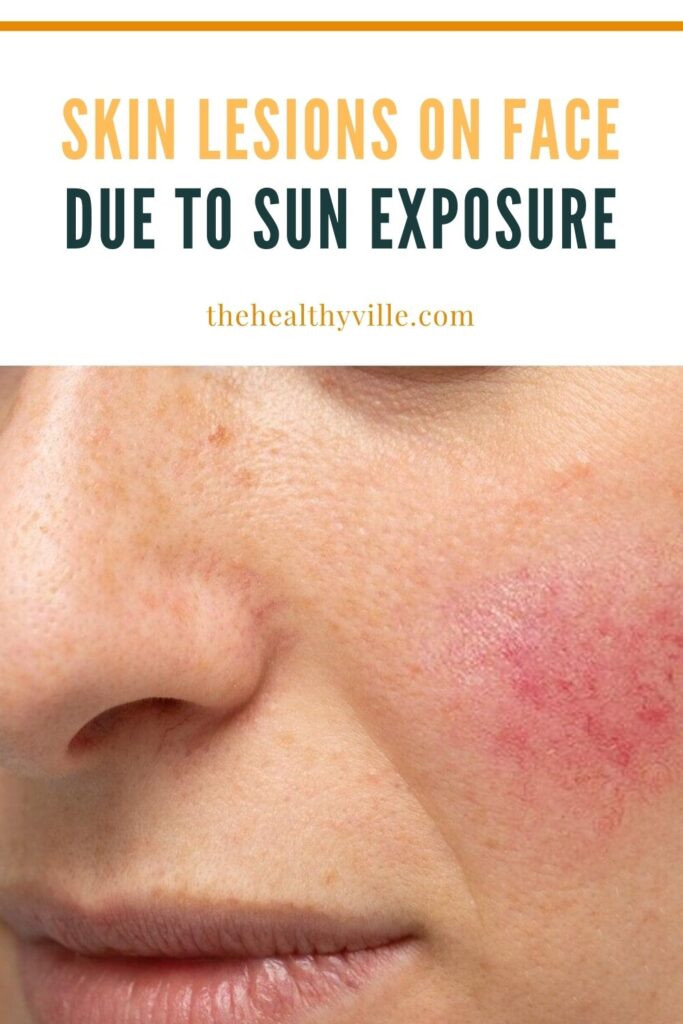Skin lesions on face happen due to sun exposure. Too much sun exposure can cause anything from a minor burn to invasive carcinoma. Interested in learning more about it?
Getting a tan and even skin is a trend that stays in effect every summer. In fact, the increase in temperature and visits to the beach are the perfect opportunity to take a little more sun. However, there are those who do not take into account the risks of skin damage from sun exposure.
Spending too much time being hit by UV rays directly has serious consequences. In fact, beyond the typical burns, allergic reactions and even cancer can occur. Do you want to know more about it?
What is solar radiation?
First of all, it is convenient to define what is solar radiation. It is made up of invisible and visible radiation. Ultraviolet A (UVA) and ultraviolet B (UVB) rays make up the invisible radiation of light and are the generators of most skin pathologies.
As detailed in a scientific article, UVB radiation is the main responsible for the harmful effects, while UVA contributes only between 10% and 20%. In summer, therefore, when outdoor activities increase, these rays are more aggressive and carry significant risks.
Skin lesions on face from sun exposure
The appearance of skin lesions on face from sun exposure is the result of lack of care when tanning or any outdoor activity. Not using sunscreen and other preventive measures is reflected in skin aggressions that become too serious. Below, we detail them.
Sunburn
Sunburns are generated by ultraviolet radiation B. They occur in any part of the body that is exposed (scalp and earlobes included). Some symptoms and signs of burns are as follows:
- Skin with a high temperature to the touch.
- Edema.
- Redness
- Sensitivity, itching and pain.
- Small blisters.
- In severe cases, headache, nausea, fatigue and fever.
These signs and symptoms usually appear a few hours after sun exposure. After a few days, the skin begins a peeling process that leads to it healing.
Premature aging
The damage that accumulates in the skin over the years can cause premature tissue deterioration or photoaging. The American Academy of Dermatology magazine conducted a study that shows that those areas of the body that were most photoexposed, advance the appearance of the signs of age by 20 years.
In particular, it increases the presence of actinic keratoses, wrinkles and blemishes. A study published in Clinical, cosmetic and investigational dermatology concludes that the sun is the generator of 80% of these skin manifestations.
Skin cancer
Sun exposure not only causes injury and aging, but increases the risk of further skin damage. To be more exact, UV rays are positioned as a primary risk factor for the development of malignant skin lesions on face.
Estimations are that around 90% of cutaneous carcinomas occur in areas with sun exposure such as the face, ears, neck, forearms and hands. How can this disease occur? There are various ways.
Melanoma
Excessive, occasional and intermittent exposure to the sun is related to the appearance of melanoma, as detailed in an article in the International Journal of Cancer. It usually develops more frequently in people with eyes and fair skin who have suffered from sunburn in adolescence or childhood.
Although it is the least frequent type of skin cancer, cases have increased in recent years. The average age of diagnosis is 57 years, and 75% of cases occur before the age of 70.
Squamous cell carcinoma (CEC)
In squamous cell carcinoma (SCC), the cells are the most superficial of the epidermis, called spiny. They represent 20% of skin carcinomas. The Skin Cancer Foundation details that those who use tanning beds, increase the risk of developing it 2.5 times more.
Basal cell carcinoma (CBC)
The cells involved in basal cell carcinoma (CBC) are located in the basal layer of the epidermis and are responsible for skin renewal. They are the most frequent skin tumors, as they correspond to 80% of the total.
Allergic reactions
Some people can develop an allergic picture from sun exposure. In fact, the American Journal of Clinical Dermatology concludes that the most common form of manifestation is through the “solar polymorphous eruption”, causing a rash and itching.
The milder cases disappear on their own, without the need for treatment. Despite this, it can occur severely, leading to treatment with tablets or topical corticosteroid products.
Actinic keratoses
Also called “solar keratoses” are precancerous lesions that are slow but steady growing. In fact, they manifest for the first time from the age of 40 in areas with exposure to the sun over time. Its most frequent location is in the auricles, scalp and face.
They are thick, scaly plaques, rough to the touch, which can alternate between brown, red or pink colors. Sometimes there’s a delay in their diagnosis as doctors may confuse them for common warts.
It is possible to avoid them?
Taking preventive measures is the best way to avoid suffering the consequences of sun exposure. In this sense, it is advisable to use a sunscreen of at least 50 SPF and protective clothing such as long-sleeved shirts, long pants and wide-brimmed hats.
Similarly, it is advisable to go regularly to the dermatologist, especially if there are abnormalities in the skin, such as a new spot or a strange nevus. In fact, the timely detection of lesions contributes to the success of the treatment.
Don’t forget to SHARE the info about skin lesions on face due to sun exposure with your friends and family on your social networks!

